Hsu Chiu-i (徐秋宜) studied to be a painter and sculptor, but now she applies the fine art techniques she learned to her one-of-a-kind clothing designs, many of which are dyed with natural indigo pigment. During a press conference for the Taipei Fabricreative Project (台北布思議) at Taipei City Hall on Friday last week, Hsu demonstrated how to turn a few yards of fabric into a sundress or a flowing Grecian goddess evening gown without sewing by using deftly executed twists, tucks and pleats.
“Working with fabric is just like sculpting,” said Hsu in an interview after the event. “It’s about manipulating space.”
Hsu’s eponymous clothing label is sold at her store Artale Workshop near Zhongshan MRT Station (中山捷運站). The space also carries items from other Taiwanese brands, including hand-painted ceramics and glass pendants by Art Lee, sterling silver accessories by Bomb Metal and Fry Jewelry (爆炸毛頭與油炸朱利), fikabrod’s felted toys and T-shirts by minono.
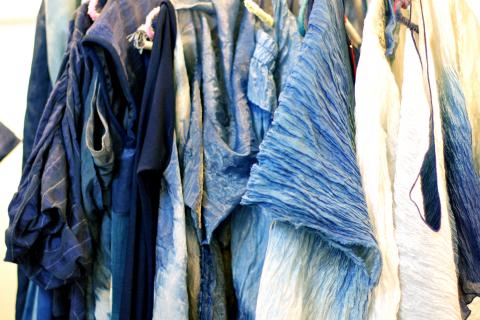
Photo: Catherine Shu, Taipei Times
Most of Hsu’s current creations are dyed with indigo pigment made from the leaves of the Assam indigo plant (馬藍, botanical name strobilanthes cusia). Her textile designs range from intricately detailed flowers to bold ombre washes.
“People link indigo dyeing with traditional clothing, but I like to experiment with ways to make it feel contemporary,” says Hsu.
In Taiwan, indigo-dyed fabrics are associated with simple shirts once worn by the Hakka, who favored the deep blue color for work clothes because it hid stains well. Sansia District (三峽區) in New Taipei City was once the center of indigo dyeing in Taiwan, but production began to decline in the early 20th century as chemical dyes became available.
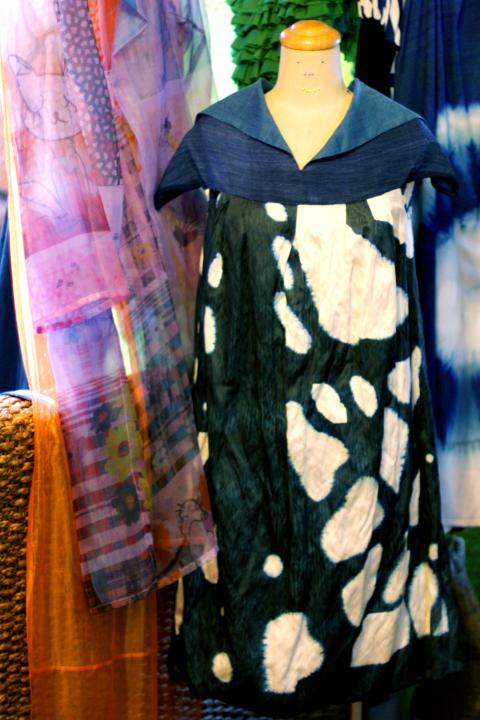
Photo: Catherine Shu, Taipei Times
Hsu hopes to revive the industry by selling enough indigo-
dyed clothing and accessories to start passing orders on to
fabric workshops.
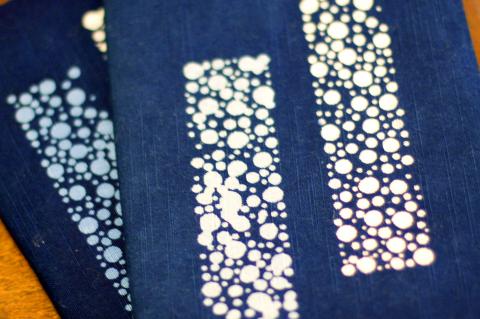
Photo: Catherine Shu, Taipei Times
Though Hsu’s clothing label, which was founded in 1996, is now best known for her indigo-dyed pieces, she did not begin working with the natural pigment until just two and a half years ago, while serving as a consultant for textile and accessory manufacturers.
“They had used indigo dyeing for little things like scarves and bags before, but they wanted me to show them how they could incorporate it into larger items like clothing,” says Hsu. “I found it fascinating.”
Traditional dyeing techniques include wax-resist, in which a pattern is first applied to the fabric using wax, or shibori, a form of tie-dyeing that originated in Japan and produces intricate patterns. Hsu, however, prefers to create larger, more dynamic designs.
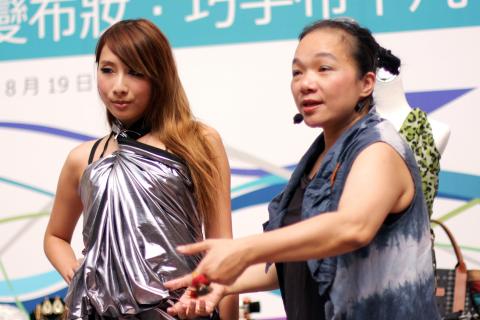
Photo: Catherine Shu, Taipei Times
“The color of indigo dyes reminds me of the clouds in Chinese paintings. I wanted to capture that sense of freedom and movement,” says Hsu. “Some of my patterns have been based on paintings by my husband [artist Wang Ren-jye (王仁傑)] and daughter, or even dogs I see while out walking.”
Though her mother was a custom dressmaker, Hsu never thought she would follow in her parent’s footsteps and went to art school to study Western painting and sculpture instead.
“I always preferred drawing. I would cut out paper dolls from my mother’s fashion magazines, but I never imagined I would enter this business,” says Hsu.
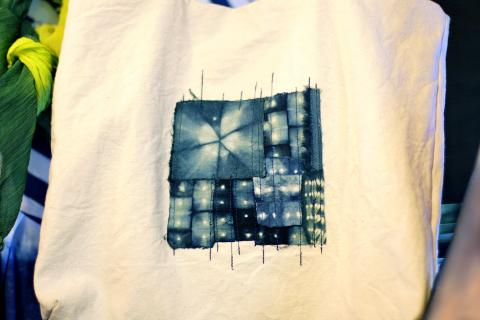
Photo: Catherine Shu, Taipei Times
After graduating from art school, however, Hsu landed a position as a textile designer, creating patterns for intarsia fabric. During the early 1990s, Hsu earned a master’s degree in fashion design at the Ecole Nationale Superieure des Arts Decoratifs in Paris. After a stint as a trends analyst for the Taiwan Textile Federation (紡拓會設計中心), Hsu launched her namesake fashion label in 1996.
Hsu dyes all her textiles at her home studio near Artale Workshop, working with fabric pieces that measure 2m or 3m each. In order to create gradations in color from the palest shade of slate to deep midnight blue, Hsu dips the cloth into the indigo dye bath several times, laying it out to dry in the sun between each immersion and repeating the process until she achieves the color she wants. Most fabric takes about three days to finish, Hsu says.
Her dresses, skirts and shirts are made to preserve and show off the painstakingly created indigo patterns.
“If you use ordinary dressmaking patterns, you cut up the design,” says Hsu. “But I also didn’t want to make dresses that just use one large piece of fabric in the front and then another in the back, so I began to experiment with draping the fabric in different ways.”
Hsu hopes to find ways to lower the production costs of indigo dyeing and encourage more designers and textile artists to work with the technique.
“Indigo is very special to me. We can preserve a traditional textile art but at the same time we also have an opportunity to modernize it, and it’s all done with environmentally friendly materials,” says Hsu. “Hopefully we can turn indigo dyeing into a viable industry again.”

May 18 to May 24 Pastor Yang Hsu’s (楊煦) congregation was shocked upon seeing the land he chose to build his orphanage. It was surrounded by mountains on three sides, and the only way to access it was to cross a river by foot. The soil was poor due to runoff, and large rocks strewn across the plot prevented much from growing. In addition, there was no running water or electricity. But it was all Yang could afford. He and his Indigenous Atayal wife Lin Feng-ying (林鳳英) had already been caring for 24 orphans in their home, and they were in

On May 2, Chinese Nationalist Party (KMT) Chairman Eric Chu (朱立倫), at a meeting in support of Taipei city councilors at party headquarters, compared President William Lai (賴清德) to Hitler. Chu claimed that unlike any other democracy worldwide in history, no other leader was rooting out opposing parties like Lai and the Democratic Progressive Party (DPP). That his statements are wildly inaccurate was not the point. It was a rallying cry, not a history lesson. This was intentional to provoke the international diplomatic community into a response, which was promptly provided. Both the German and Israeli offices issued statements on Facebook

Even by the standards of Ukraine’s International Legion, which comprises volunteers from over 55 countries, Han has an unusual backstory. Born in Taichung, he grew up in Costa Rica — then one of Taiwan’s diplomatic allies — where a relative worked for the embassy. After attending an American international high school in San Jose, Costa Rica’s capital, Han — who prefers to use only his given name for OPSEC (operations security) reasons — moved to the US in his teens. He attended Penn State University before returning to Taiwan to work in the semiconductor industry in Kaohsiung, where he

President William Lai (賴清德) yesterday delivered an address marking the first anniversary of his presidency. In the speech, Lai affirmed Taiwan’s global role in technology, trade and security. He announced economic and national security initiatives, and emphasized democratic values and cross-party cooperation. The following is the full text of his speech: Yesterday, outside of Beida Elementary School in New Taipei City’s Sanxia District (三峽), there was a major traffic accident that, sadly, claimed several lives and resulted in multiple injuries. The Executive Yuan immediately formed a task force, and last night I personally visited the victims in hospital. Central government agencies and the